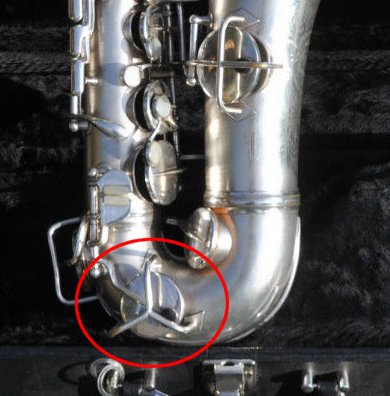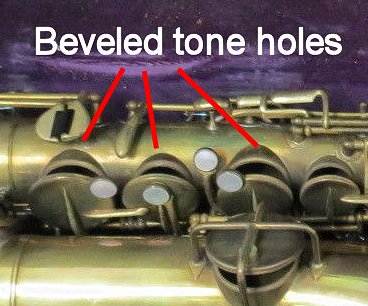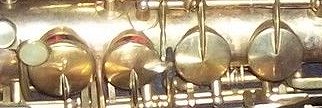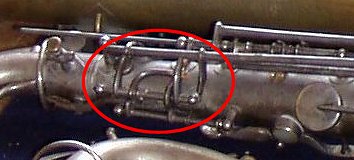|
Stencil Saxophone List
by Paul D. Race
As explained in our article Evaluating Vintage Saxophones explains, “Stencils” are vintage saxophones saxophones that were made by “name brand” companies like Buescher, Martin, and Conn, but labeled for other companies. Usually they had fewer features, less engraving, etc., but at least they were solid compared to offbrand horns. A Buescher, Martin or Conn stencil that can be restored to playability without major expense will last far longer than, say, the off-brand Chinese-made horns flooding the Internet today. That said, vintage horns are an acquired taste, and their purchase is best left to folks who already play sax well, so you have some idea of what you’re getting into.
This page provides a list of "stencil" names that have been reported, and the manufacturers that have been identified as producing that brand at some point in time. This list had been compilied by consulting several experts and generally authoritive internet sites. It's as complete and correct as I could make it as of January, 2014, but I'm sure that it is neither as complete or as correct as it I would like it to be:
- Some stencils were made (or survived) in such small quantities that they haven't shown up on anyone's radar yet.
- Some collectors have attributed individual stencil horns to the wrong manufacturer, and the rest of us have no way of proving them wrong any more than we can prove that Bigfoot doesn’t exist.
You'll notice that many of the stencil names list multiple providers. That can be due to:
- Companies who changed providers every so often, depending on whoever offered the best wholesale cost at a time
- Companies that ordered different kinds of horns from different providers
- Stencils whose manufacturers have been misidentified and gone into the "canon" that way.
Keep in mind that stencils usually lacked features that made the name brand versions popular, such as Conn's rolled tone holes, Buescher's Man-in-the-Moon neck brace, high F or F# keys, certain trill keys, fancy engraving, exceptional quality control etc. But if a horn came off the same line as, say a Buescher True-Tone or Conn New Wonder, at least you know it wasn't thrown together in a startup factory somewhere.
Note: Most stencils were produced during the “golden age” of home saxophone playing, say 1915-1932. So there is a relatively high proportion of C Melody horns - the ultimate home saxophones. But in addition, note that all but a handful of stencils are based on first-generation Low Pitch saxophones, such as the Buescher True-Tone. If you’re looking for a vintage pro or semi-pro American-built horn, such as a Buescher Aristocrat or 400 or Martin Imperial, or Conn New Wonder II or Naked Lady, you will not find a stencil equivalent. That said, Ragtime, Dixieland, and Swing were invented on first-generation Low Pitch horns, like the Buescher TrueTones and the Conns, Martins, and Kings of the same generation. So those horns and many of their stencil equivalents still have a lot to offer a player looking for a solid, good-sounding horn.
Consider this list a starting point. If you see a horn you like with one of the brand names below, and you're wondering if it's really a stencil of Martin, Conn, or Buescher, do some internet research on the comparable horns that the brand name was producing to see if the reported factory even made that horn. 
Here are some tips that should point you in the right direction:
- Alleged Conn Stencils: If Alto, C Melody, or Tenor saxes has been reported as a "Conn stencil," check to see whether the protector over the low C pad has a "Mercedes-shaped" design. Almost no one else, used that pattern, although it has been observed on at least one Couturier-built sax with Gretsch engraved on the bell (Couturiers have beveled tone holes, though a feature Conn never used).
Note: Since I wrote the above, I have come across a purported Conn stencil on eBay that wasn’t built by Conn or Couturier, or anyone I know. It had a Mercedes-shaped low C guard, but nothing else that would indicate that it was built by Conn, Courturier or any other brand I’ve studied. Again, it might be a fine horn, but false claims like this leave a bad taste in my mouth. 
- Alleged Martin Stencils: Martin used beveled tone holes even on their stencil horns. The relatively skinny edge of the opening made it easier for pads to seat and seal. Very few horns that don’t seem to be Martin have this feature.
Exceptions include Couturier saxes, which also may have beveled tone holes. They sometimes have “Gretsch” on the bell since Gretsch began distributing them in 1922. 
- Alleged King Stencils: King/White keys used a unique “cupped” shape that makes most of their stencils relatively easy to determine at first glance.

In addition, many vintage King and King stencil octave keys included a graceful curved mechanism that is seldom seen on other horns.
- Alleged Buescher Stencils: Buescher lovers can spot a Buescher-built horn from miles away, because they become so familiar with the proportions of the thing. There are also several features, including an off-center octave key mechanism, that seem to be unique to Buescher. But as soon as I decide that some key design is unique to Buescher, I see another, rare, saxophone that includes that feature and is definitely not Buescher. Many internet saxophone “experts” start by ruling out Conn, Martin, and King, then they start comparing photos before th
 ey’ll settle on Buescher. ey’ll settle on Buescher.
Every Buescher stencil I’ve seen so far is based on the Buescher True-Tone. All of them lack the triangular True-Tone logo under the thumb hook, and most of them lack the “man-in-the-moon” neck brace (right). If you find a Buescher stencil with this neck brace, it’s likely identical to the True-Tone of the same year.
 Many Buescher stencils also lack the potentially deadly two-piece bow protecter (right), but even the Buescher stencils have a more distinctive bow protecter than the average saxophone. Many Buescher stencils also lack the potentially deadly two-piece bow protecter (right), but even the Buescher stencils have a more distinctive bow protecter than the average saxophone.
If you see a vintage horn you like and the vendor is claiming that it is really a stencil of such-and-such brand, he or she may be making it up, misinformed by an "expert," or basing the claim on partial knowledge. In some cases, an erroneous claim is innocuous, such as claiming that a Buescher stencil is really a Conn stencil - both brands made nice stencil horns, so there's no attempt to inflate the value of the horn. In others, the false claim seems to be a deliberate attempt to inflate value - presenting a true off-brand piece of junk as a Buescher stencil, for example.
US Stencils: The most common versions of most Conn, Martin, and Buescher vintage saxophones are well represented on the Intenet. If the horn in question is supposed to be a stencil of one of those, Google until you find sites with good examples and a lot of photos, and compare those to the sax in question. There may be missing features, but the proportions and 95% of the mechanics of the horn will be the same. Again you may discover that the vendor has simply called a Martin stencil a Conn or vice versa. No big deal. But if the horn you're looking at doesn't look like anything you can find by Conn, Buescher, King, OR Martin, it may just be an off-brand, period.
European Stencils: A few European companies, such as Malerne, Keilwerth, and Evette & Schaeffer, made stencil horns that found their way to this continent. If the brand name of the horn you're looking at cross-references to one of those companies, your research will be a little harder, since far fewer examples have survived. Also a European-made stencil may be harder to find parts for, so look for horns with zero mechanical problems. Vintage Keilwerth and Evette & Schaeffer have relatively good reputations, if that helps.
Because the vintage saxophone market is plagued with honest mistakes and deliberate misinformation, you will need to check out the claims of vendors. For example, Selmer did not have a factory in the United States until they bought out Buescher in 1963. Yet I occasionally see a vintage US-made sax being called a Selmer stencil. Not a chance. (By the way “Selmer New York” horns are stencils, but they’re made by Buescher and reputedly by other companies, not Selmer.)
Finally, just knowing that, say, Buescher made a particular model is just a starting point. Even if the stencil horn has every feature you need and most of the advantages of the name brand version, you still have to examine it carefully and determine if it can be made playable without costing more than the thing will ever be worth. Our article on Evaluating Vintage Saxophones should give you some tips.
The List:
Remember - these are based on reports that at least one stencil with the brand names listed below was “tracked down” to the factory or factories listed, not a claim that all stencils of that brand name were made in the same factory, or even that the original report was correct. “Observed” means that I’ve had my hands on a horn or seen detailed photos that convinced me of a stencil’s manufacturer. The vast majority of these, however, I’ve never seen enough of to make a claim based on personal experience.
Each listing is just a starting point, and it’s up to you do to “due diligence” when you’re sorthing things out. Your mileage will vary.
Happy hunting!
- Acme: Malerne
- Abbott Premier: Conn, Martin
- Adophe: Selmer (France)
- Alexandre: Keilwerth
- American Artist: Buescher, Conn, Martin
- American Capitol: Buescher
- American First: Conn
- American Hagar: Conn
- American Perfecto: Conn
- American Perfection: Martin
- American Premier: Buescher
- American Professional: King (H.N. White), Martin
- American Scholastic: King (H.N. White)
- American Standard: King (H.N. White)
- American Triumph: Buescher, Conn
- Armstrong Heritage: Keilwerth
- Artist: Buescher
- Artiste: Malerne
- B & H Edgeware: Keilwerth
- B & H Fogware: Keilwerth
- Bandmaster: Conn, Keilwerth, Martin
- Beaufort American: Conn, Martin
- Bel Canto: Martin
- Blessing: Buescher, Martin
- Bruno, Bruno Perfectone: Conn, Buescher, Martin
- Buffet: Keilwerth
- Buffet Dynaction: Malerne
- Bundy: Buescher, Conn, Keilwerth
- Bundy Special: Keilwerth
- C.J. Spangler: Conn
- Cafaro Special: Buescher
- Carl Fischer: Buescher, Conn, Malerne
- Cartier: Malerne
- Cavalier: Conn (an “in-house” stencil)
- Champion: Martin
- Cleveland: techically King, but generally made in the old Cleveland plant, so not the same as King-branded horns
- Criterion: Malerne
- Cole & Dunas: Buescher
- Colonial: Martin
- Columbian: Conn
- Commodore: Conn
- Commander: Martin
- Commonwealth: Conn
- Community: Malerne
- Concertone: Conn, Martin
- Continental: Conn
- Continental Colonial: Conn
- Couesnon: Martin
- Couf: Keilwerth
- Couturier: Couturier saxes were made by Couturier (later bought out by Lyon & Healy then Holton, but still making “Courturier”-branded horns). Because many of the horns have beveled tone holes, they may be mistakenly attributed to Martin. To make it even more complicated, some have the Mercedes-style low C guard, so they occasionally get mistaken for Conns. A few late-1920s Couturier saxes are reputed to have Couturier-style bodies and Holton-style key-work.
- Corvair: Keilwerth
- Croydon: Malerne
- Crusader: Buescher, Conn
- De Villier: Keilwerth
- Deville: Selmer (France)
- Dick Stabile: Martin
- Diplomat: Malerne, Martin
- Ditson: Buescher
- Dorn & Kirschner: Martin
- Elkhart: Martin (1923 until c1927, observed), Buescher (after c1927, observed), Conn (Claimed. If you come across one it is probably pre-1927, when Buescher and Elkhart merged)
- Elkhorn: Buescher
- Gary: Martin
- Getzen: Buescher
- Gladiator: King (H.N. White)
- Gold Star: Martin
- Grand Opera: Conn
- Grenadier: Malerne
- Gretsch: Couturier (observed), Buescher (observed), Holton (reasonable, since Holton and Couturier merged), Conn (rumored - might be a Couturier which occasionally had a Mercedes C# key guard), Martin (rumored - might be a Couturier, which are often confused because of Couturier’s beveled tone holes)
- H.N.White: King (H.N. White owned King)
- Hallmark: Malerne
- Hamilton: Conn
- Harmony: Martin
- Harry Pedler: Conn
- Harwood: Conn
- Harwood Professional: Buescher
- Honercomb: Martin
- Horace: Conn, Martin
- Indiana: Martin (an "in-house" stencil)
- Jenkins: Conn, Buescher, Martin
- Kalashen's Kleartone or Klaritone: Conn
- Keefer: Conn
- King: H.N. White, Courturier
- King Tempo: Keilwerth
- Kingston: Martin
- Knickerbocker: Martin
- La Pacific: Conn
- Leggett Special: Malerne
- Legionnaire: Buescher
- Lefleur: Conn
- Lewin: Martin
- Liberty: Conn
- Liberty C. K. C.: Conn
- Linton: Malerne
- Lyceum: Malerne
- Lyon & Healy: Buescher, Martin, Conn, Courturier
- Lyons Monarch: Buescher
- Lyric: Martin
- M. Pierre: Malerne
- Manhattan: Martin
- Marco: Keilwerth
- Martelle: Keilwerth, Malerne
- Mastercraft: Martin
- Mead: Martin
- Melody Master: Martin
- Midwest: Martin
- Mercury: Malerne
- Music Center: Malerne
- New King: Keilwerth
- Oliver Ditson: Buescher, Martin
- Olympian: Conn, White
- Orpheum Super: Conn
- Pan-American: Conn (an "in-house" stencil)
- Pedler: Martin
- Perfacktone: Buescher, Conn, Martin
- Perfecktone: Conn, Martin
- Perfection: Conn
- Premier American: Martin
- Pride of Elkhart: Conn
- Reynolds: Martin
- Royal Artist: Buescher
- Rudy Wiedoeft: Holton
- Roxy: Keilwerth
- Sears & Roebuck: Conn, others likely, since Sears would look for lowest bidder.
- Selmer Major (Dusseldorf): Keilwerth (observed, unusual in that it used Balanced-Action-inspired ergonomics in the 1960s while Selmer’s American-built “second-tier” horns were still using early-20th century Buescher ergonomics.)
- Selmer New York: Buescher, Conn (observed - I own a Buescher-made version)
- Selmer USA: Conn, Buescher
- Senator: Keilwerth
- Sherwood: Buescher, Conn, Martin
- Silvertone: Buescher, others likely, since Sears would look for lowest bidder.
- Spangler: Buescher
- Standard Artists: Martin
- Standard American: Martin
- Supertone: Buescher, Conn, Martin
- Supertone Professional: Martin
- Supreme Custom Made: Malerne
- Symphony: Conn, Martin
- Tempertone: Martin
- Tom Brown: Buescher, Conn
- Tone King: Keilwerth
- USA: Buescher
- Varsity: Conn
- Vega: Conn, Buescher, Martin, King, Evette & Schaeffer, and White
- Velvetone: Conn
- Viking: Martin
- Virginian: Conn
- Vocotone: Buescher
- W.M. Frank Company: Martin
- Werlein Special: Conn
- Weymann: Buescher
- Whittle Zenith: Conn
- Winsor: Buescher
- Wm Meyer American: Conn
- Wolverine: York, Buescher
- Wurlitzer: Martin (observed), Conn, and Buescher
- Yankee: Buescher
- Xcelo: Conn
Note about: In-House Stencils:
Unlike most stencils, which were produced under contract for other companies “in-house” stencils were produced to provide a low-cost alternative to name-brand horns and to allow sales to second-tier music stores in “protected territories.”
The following are four “in-house” stencils we know about.
- Pan-American: Conn was an "in-house" stencil with tooling differences from the Conn line. For example, it didn’t have Conn’s signature “rolled tone holes.” The tooling was eventually used on postwar Conn Director student horns.
- The Martin Indiana was named after a company Martin bought out. However, many features of the Martin were usually carried over, including the beveled tone holes.
- The King Cleveland was made in the old Cleveland factory after King's owners (H.N.White) bought them out. Though it has a decent reputation, it is more similar to Cleveland than to contemporary King horns.
- The Buescher Elkhart was based on 1914 Buescher True-Tone Design, introduced to maintain a student line after Buescher introduced the Aristocrat and 400. Note: Because several musical instrument companies were based in Elkhart, other companies are reported to have used the Elkhart name from time to time, so this refers only to the Buescher-manufactured horns. (I started out on a 1962 version.
Other Resources
Rick Rajca, a Greenwich Village woodwind guru, put together a page on stencil horns. It includes links to closeup photos of several features that might help you identify Conn, Martin, Buescher, or King Stencils.
Other articles you may find helpful include:
Another resource, the Horns in My Life articles describe various saxophones (and one flute) with which I’ve made a personal connection over the last 45 years. Some folks who’ve had similar horns will find it a helpful resource. Others will just like to reminisce along with me. On the other hand, if you come across one of these horns while you’re shopping for a saxophone and want to know more about it, you may find one or more of the articles helpful.
The list is in the sequence in which I owned the following horns, not in the sequence they were built, which is way different.
All material, illustrations, and content of this web site are copyrighted © 2011-2014 by Paul D. Race. All rights reserved.
For questions, comments, suggestions, trouble reports, etc. about this web page or its content, please contact us.
| Visit related pages and affiliated sites: |

|
 |
 |

|

|

|

|

|

|

|

|

|

|

|

|

|

|

|
|